
Ukraine struck Russian territory with at least 13 missiles and 84 drones, triggering a fire at an oil refinery in the southern Rostov region that burned for hours, Russian officials said on Thursday (19 December).
As Russia advances at the fastest pace since the start of the war in 2022, Ukraine has repeatedly tried to strike Russia’s oil infrastructure – which funds a significant chunk of the Russian war economy.
Russian air defences shot down 84 drones over Russian regions, including 36 over Rostov region, according to the defence ministry.
Rostov Acting Governor Yuri Slyusar said Ukraine had struck the region with at least 13 missiles and dozens of drones, triggering a fire at the Novoshakhtinsk oil refinery, which has repeatedly been targeted by Ukraine.
At least one person was injured during the attack, Slyusar said. The fire was put out early on Thursday.
Drones have attacked another oil depot in Russia, this time in Novoshakhtinsk, Rostov region. A massive fire has broken out. pic.twitter.com/X8axXqxe7R
— KyivPost (@KyivPost)
It was not immediately clear which missiles Ukraine fired at Rostov, though Kyiv struck a Russian military airfield earlier this month with US-made ATACMS missiles prompting a major Russian attack on Ukraine’s energy infrastructure.
After approval from the administration of US President Joe Biden, Ukraine struck Russia with six US-made ATACMS on 19 November and with British Storm Shadow missiles and US-made HIMARS on 21 November.
Russian President Vladimir Putin, after those attacks, fired a new intermediate-range hypersonic ballistic missile known as “Oreshnik”, or Hazel Tree, at Ukraine on 21 November.
Andriy Kovalenko, the head of Ukraine’s official Centre Against Disinformation, wrote on Telegram that the missile attack focused on the Kamensky chemical plant “which produces rocket fuel specialising in solid fuel components for rocket engines”.
Reuters could not independently verify battlefield accounts from either side.
We give you energy news and help invest in energy projects too, click here to learn more





